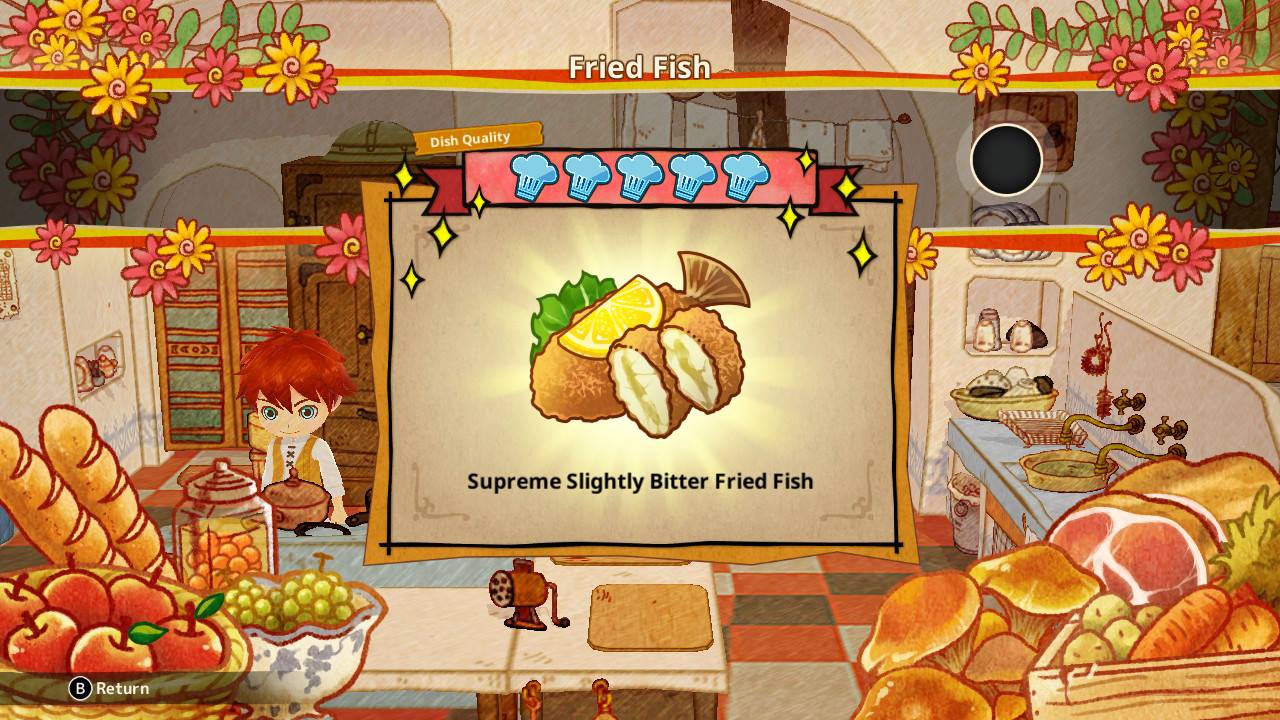Little Dragon’s Cafe is by no means a difficult game, but it’s a light introduction to the management simulation genre that’s perfect for kids and adults alike. One would expect nothing less from Yasuhiro Wada, the creator behind the beloved Harvest Moon series, which is now best-known for providing the blueprint to indie megahit Stardew Valley.
Still, even though most aspects of this relaxing ode to nostalgia are relatively straightforward, if you’re trying to maximize your cafe’s haul, there’s a couple things you need to know. Here’s a beginner’s brief on how to make the most of your coffee-slinging experience.
More than anything, don’t forget to feed your dragon.
If your play style is anything like mine, it can be tempting to just pat your dragon on the head to give them their life back in tiny bursts without having to waste a dish.
But if you don’t feed the creature, you won’t get any Manure, which is the most precious resource in the game. Even on days when you don’t need to go gather radishes or carrots in the woods, make sure to feed your dragon at least one dish.
You should also be sure to feed them before 9 PM, if you can – that’s when the critter jaunts off to bed to sleep. Also, as the dragon grows and gets bigger, you’ll need to feed it more plates of grub to get the same amount of Dragon Manure, so get cooking.
Use your Manure in the garden or in the fish farm, rather than individual forage spots.
While you have a higher chance to get rare or high-quality ingredients from forage spots, running out of general ingredients such as you’d grow in your character’s garden is actually a way bigger concern. The best way to refresh the pantry is to use Manure to turbocharge the cooldown bar in the garden. As the game goes on, you get more and more from each haul due to your wider selection, so it gets better and better.
The one exception to this is when you’re trying to make a hyperspecific recipe for a guest. When that happens, it can sometimes be helpful to use the Manure on spots where you know the ingredient might be found. In general, keeping it closer to the cafe building will increase your productivity, allowing you to collect plenty of raw materials while also waiting on tables and the like.

Night is the absolute best time to forage for mundane ingredients.
If you’re running out of carrots or the like, or you just want a lot of time to explore a new area, this is the best time to do it. Just don’t forget to take some food with you to feed your dragon, so you won’t get caught out having to pat his head for an in-game hour.
As the story progresses, you might sometimes find new recipe fragments in places you’ve already been.
It can be a little disorienting at first, especially in nooks and crannies of the island that you don’t necessarily go to that often, but it’s worth it to give it a look-around every time a new guest graces your inn.
Take a mental note of what areas of the island are off-limits to you, and what forms these obstacles take.
You gain the ability to destroy piles of wood by degrees as you progress through the story, so if you have a general idea of what areas are blocked by what, you’ll know where to go when you finally get these new abilities. The game doesn’t really have a map, so you might have to wonder around until you find your latest stomping ground.
If you’re struggling with customer satisfaction, it’s usually a lax employee.
A lot of factors appear to go into the report card you get at the end of each day, but I only ever received dire marks when I was too busy gallivanting in the forest to prevent employees from slacking off.
If you’re actually inside the cafe at rush hour, it’s more efficient to do most of the tasks yourself than taking the time to harass Billy into actually doing his job. But over time, that slacking can really make the difference between a satisfied customer and a dissatisfied one. Talking to them frequently seems to help, too.
Incidentally, this advice works really well in the real world too!

Make sure to pop in during rush hour.
If you want to increase your cafe’s influence, you’ll want to be on hand during peak hours: 12pm to 2pm and 6pm to 8pm.
You get the vast majority of your slavering customers in those two intervals, and your crew could definitely use your help taking orders and carrying dishes to and fro – otherwise, they’ll start slacking. Your performance at these tasks weighs heavily in your final grade for the day, so it’s important to make it a priority.
That being said, as far as I can tell, you pretty much always gain influence even if you do a terrible job — it’ll just take longer if you don’t put the effort in.
You don’t actually have to sleep.
Yes, unlike Harvest Moon, there are apparently no real penalties for neglecting your beauty sleep — you won’t get sick, and your employees won’t say anything, either.
That being said, sleeping is the only way to save your game, so make sure to jump in the bed every now and then to avoid losing your progress. There are also points in the story where you have to sleep in order to progress a plot — check the Story tab for that.
Going to sleep early has consequences.
At least in my experience, the cafe will completely cease to function in your absence, which gives you the worst possible score, and might have a deleterious effect on the number of customers you have over the next few days. That, in turn, can severely stunt your influence. One or two bum days like that won’t ruin you, but I wouldn’t make it an everyday occurrence.
The “Running out of ingredients” message doesn’t always mean you’re actually running out of ingredients.
It’s unclear if this is a bug or just an oddly-tuned warning, but you’ll often get it, even when you don’t necessarily need to switch out your offerings.
Take a look at your menu — if you see a dish that says “running out” or “can’t make,” then you definitely do need to change it. If not, you’re probably okay, at least for the time being. Take a look at the report screen at the end of the day to see what you need to gather for tomorrow.
It never hurts to change out some of your menu items.
Even if your cafe’s already performing well, this has a positive effect on morale. And the minigame is fairly engaging, so why not try it?
Talk to your staff and the customers who come in every day.
In particular, your “Helper” will often give you recipe fragments, and your other staff will give you entire recipes at a time. Make sure to turn them into the Wizard in your mom’s room. The customers will often give you mundane ingredients, but every bit helps, and it only takes a few seconds.

Triggering the next cutscene in the story can sometimes be a pain.
In general, it seems like “daylight hours” means after 8 AM, and the evening is somewhere after 5 PM. If you can’t seem to get the flag to go, try leaving the cafe and coming back in, or going up the elevator and back down. It’ll happen eventually.
The Story tab is incredibly useful for this, because the flags are often far from intuitive.
If all else fails, try going to sleep! This is another technique that works in the real world as well.
Where to get the Powerful Zucchis for Poncho’s story
Most of this guide is general advice, but this particular item is such a pain I thought it was worth special mention. When you’re doing Poncho’s story, the Powerful Zucchis you need are hiding on the bluff to the right of the first rock you push to get into the next area.
They’re huge and red, but these guys can be hard to find. Just climb around that bluff and you’ll eventually see them.
To get a five-star dish, you need to hit every note perfectly.
This is probably the most demanding part of the game, so make sure to pay attention and try to nail it. Still, if you mess up one, don’t be too put out, as you have to miss a good number of notes to get demoted to 3-star. The bonuses for a perfect dish are substantial, however, so try to master it as soon as you can.
Relax.
Little Dragon’s Cafe might have some frantic moments, but all in all, it’s a slow game, designed to center you after a long day at work. Don’t take it too seriously, and you’ll have a good time!


